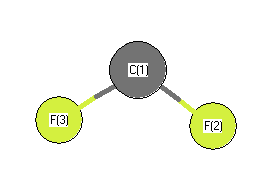Jump to
S2C1
Energy calculated at CCSD/cc-pVTZ
| | hartrees |
|---|
| Energy at 0K | -237.396380 |
| Energy at 298.15K | -237.396173 |
| HF Energy | -236.755044 |
| Nuclear repulsion energy | 64.948582 |
The energy at 298.15K was derived from the energy at 0K
and an integrated heat capacity that used the calculated vibrational frequencies.
Geometric Data calculated at CCSD/cc-pVTZ
Point Group is C2v
Cartesians (Å)
| Atom |
x (Å) |
y (Å) |
z (Å) |
|---|
| C1 |
0.000 |
0.000 |
0.592 |
| F2 |
0.000 |
1.028 |
-0.197 |
| F3 |
0.000 |
-1.028 |
-0.197 |
Atom - Atom Distances (Å)
| |
C1 |
F2 |
F3 |
| C1 | | 1.2961 | 1.2961 |
F2 | 1.2961 | | 2.0553 | F3 | 1.2961 | 2.0553 | |
 More geometry information
More geometry information
Calculated Bond Angles
| atom1 |
atom2 |
atom3 |
angle |
|
atom1 |
atom2 |
atom3 |
angle |
| F2 |
C1 |
F3 |
104.906 |
|
Electronic energy levels
Charges, Dipole, Quadrupole and Polarizability
Jump to
S1C1
Energy calculated at CCSD/cc-pVTZ
| | hartrees |
|---|
| Energy at 0K | -237.309877 |
| Energy at 298.15K | -237.309580 |
| Nuclear repulsion energy | 62.496098 |
The energy at 298.15K was derived from the energy at 0K
and an integrated heat capacity that used the calculated vibrational frequencies.
Geometric Data calculated at CCSD/cc-pVTZ
Point Group is C2v
Cartesians (Å)
| Atom |
x (Å) |
y (Å) |
z (Å) |
|---|
| C1 |
0.000 |
0.000 |
0.497 |
| F2 |
0.000 |
1.132 |
-0.166 |
| F3 |
0.000 |
-1.132 |
-0.166 |
Atom - Atom Distances (Å)
| |
C1 |
F2 |
F3 |
| C1 | | 1.3119 | 1.3119 |
F2 | 1.3119 | | 2.2642 | F3 | 1.3119 | 2.2642 | |
 More geometry information
More geometry information
Calculated Bond Angles
| atom1 |
atom2 |
atom3 |
angle |
|
atom1 |
atom2 |
atom3 |
angle |
| F2 |
C1 |
F3 |
119.305 |
|
Electronic energy levels
Charges, Dipole, Quadrupole and Polarizability
